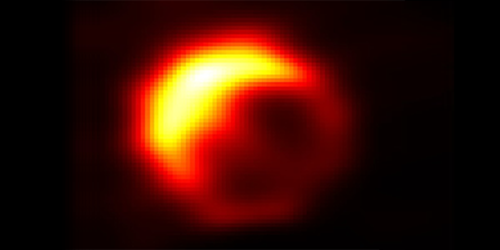Testing General Relativity in a Black Hole’s Shadow
The Event Horizon Telescope (EHT), a planet-wide network of radio telescopes, is compiling the first direct image of the giant black hole in the center of our Galaxy. The trapping of light by the hole will produce a dark shadow surrounded by a bright circular ring. A new analysis shows that the EHT could potentially detect small deviations in the shadow size, which are predicted by alternative theories of gravity.
Like most galaxies, our Milky Way has a supermassive black hole, called Sagittarius A* (Sgr A*). Observations of stars orbiting Sgr A* have provided estimates of its mass (about 4 million solar masses) and its distance from us (roughly 27,000 light years). The radius of the black hole, defined by its event horizon, is just 17 times that of the Sun. To image this compact object, astronomers formed the EHT project, which performs interferometry on data from several radio telescopes from around the globe. The group expects to have the first snapshot of Sgr A* in the next few years.
According to general relativity, the warping of space around Sgr A* creates a shadow with an apparent radius of exactly 50 microarcseconds. By contrast, many alternative gravity theories predict a larger or smaller shadow. Tim Johannsen from the Perimeter Institute for Theoretical Physics, Canada, and colleagues analyzed a previously constructed simulation of EHT data for Sgr A*. They first showed that the EHT will dramatically reduce the uncertainties in the mass and distance measurements. They also describe in detail how the EHT will test general relativity by measuring certain spacetime deviation parameters that have nonzero values in alternative gravity theories.
This research is published in Physical Review Letters.
–Michael Schirber





